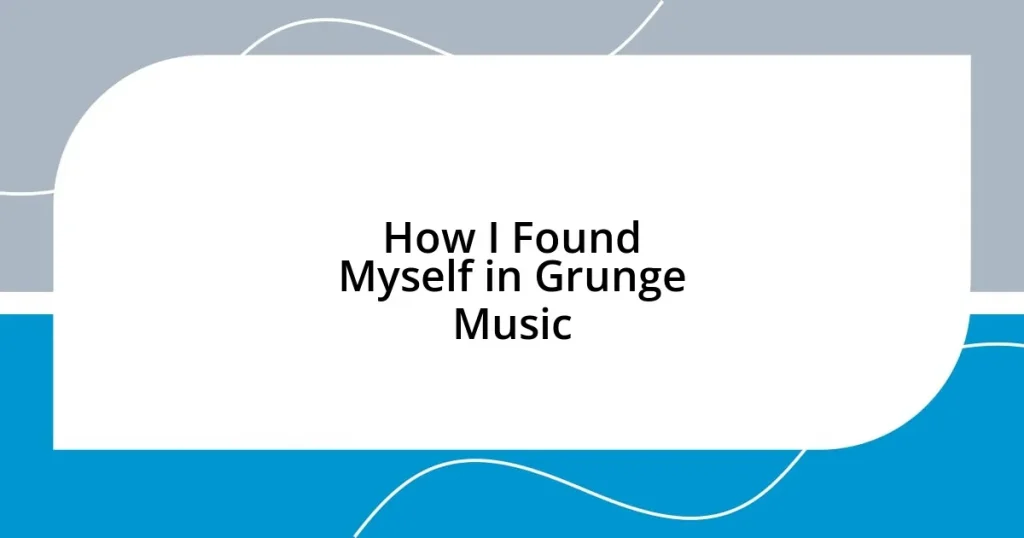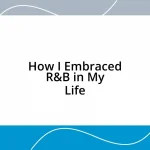Key takeaways:
- Grunge music became a personal outlet during the author’s teenage years, resonating with feelings of confusion and isolation.
- The genre emerged in Seattle in the late 1980s, characterized by its raw sound and introspective lyrics, influenced by punk and heavy metal.
- Key bands like Nirvana, Pearl Jam, and Soundgarden shaped the grunge movement, addressing themes of pain, vulnerability, and rebellion.
- Grunge’s cultural impact fostered a sense of community and authenticity, encouraging open conversations about mental health and self-acceptance.
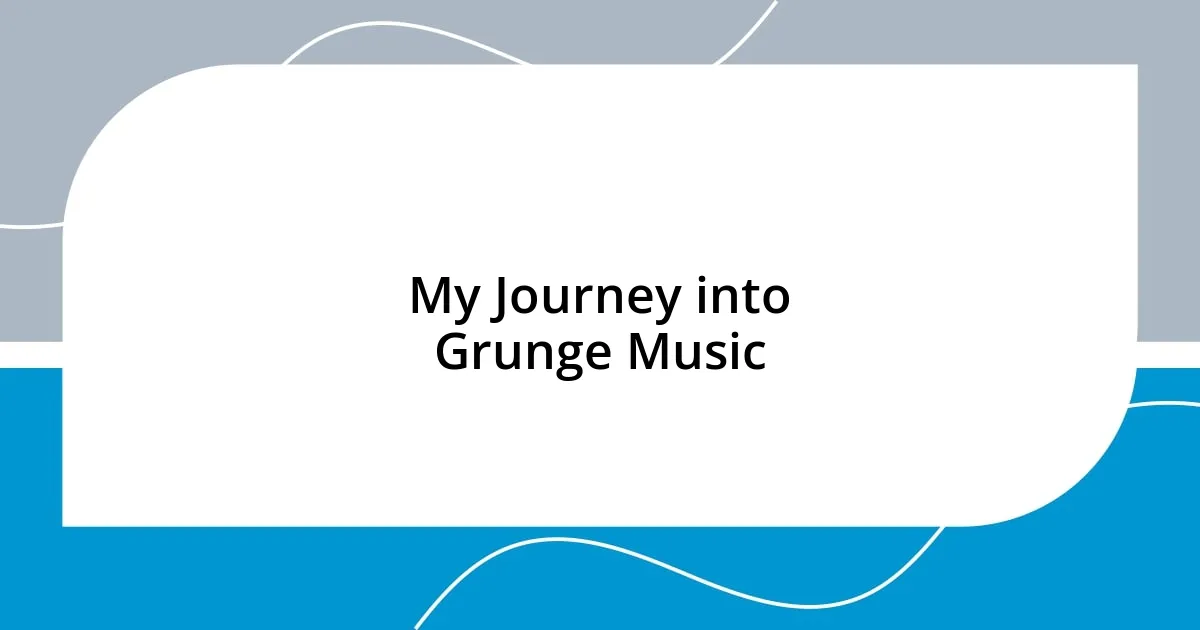
My Journey into Grunge Music
Grunge music first found its way into my life during my teenage years, a time when I was grappling with my own identity. I remember flipping through my brother’s old vinyl records when “Smells Like Teen Spirit” blasted out of the speakers. The raw energy and angst in Kurt Cobain’s voice struck a chord; it was as if he was channeling all the confusion and disillusionment I felt at the time.
As I delved deeper into the grunge scene, discovering bands like Pearl Jam and Soundgarden, I found that their lyrics spoke to experiences I couldn’t articulate. I vividly recall lying on my bedroom floor, surrounded by posters and scribbled notes, feeling a mix of solace and rebellion as I sang along to “Black” and “Spoonman.” Did the music serve as a soundtrack to my struggles? Absolutely. I felt understood, and that emotional connection was profound.
Eventually, I began attending local shows, where the vibe was raw and visceral. There was this unique thrill in being part of a crowd that shared the same intense feelings. During one unforgettable concert, I found myself crowd-surfing, euphoric and liberated—an exhilarating moment when I realized that grunge wasn’t just a genre; it was a powerful outlet for every moment of isolation and passion I had ever faced.
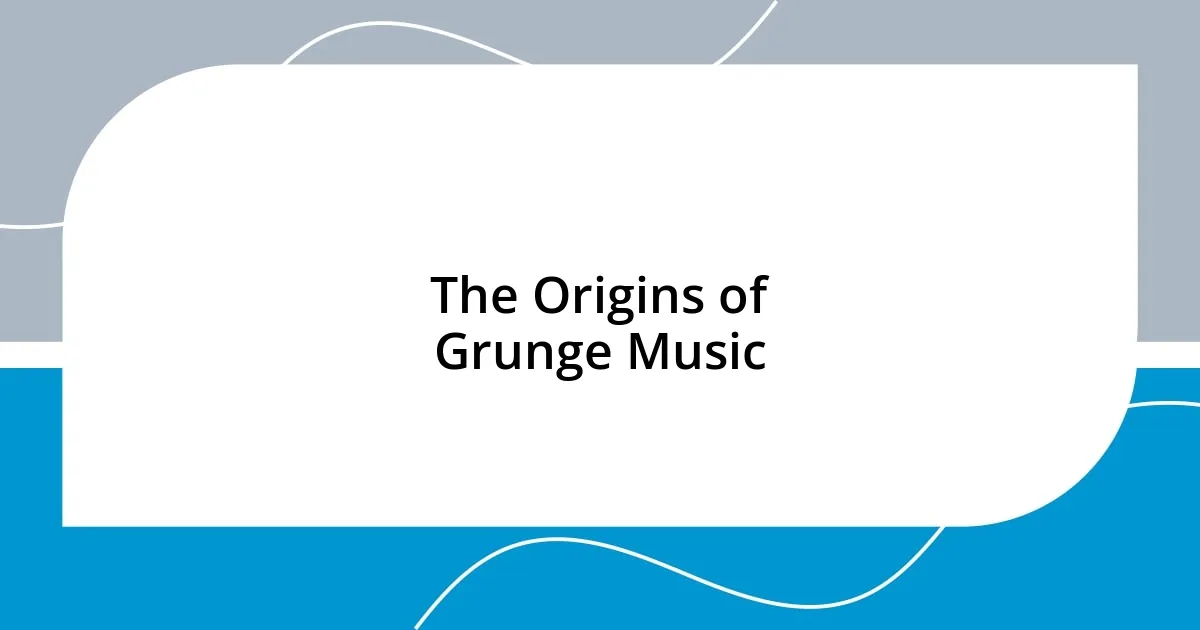
The Origins of Grunge Music
Grunge music emerged in the late 1980s in Seattle, a city uniquely shaped by its industrial backdrop and an emerging underground scene. I often think of the vivid imagery of damp streets and coffee shops bustling with creative minds, where bands like Nirvana and Alice in Chains rehearsed in small garages. This environment brewed a sound that was both gritty and authentic, reflecting the disillusionment felt by a generation.
At its core, grunge was a response to the glitter and glam of the 1980s rock scene. I remember the first time I came across a comparison between hair metal bands and the raw honesty of grunge; it was like a light bulb went off. The deliberate embrace of imperfections and heavy emotions became an antidote to the over-the-top personas I had grown accustomed to. I found it refreshing—this was music that didn’t shy away from expressing pain and vulnerability.
As I explored the roots of grunge, it became clear that it was deeply intertwined with punk influences and DIY ethics. I recall reading about how these bands rejected mainstream expectations, opting for a sound that was both heavy and melodic. This resonated with me personally; I felt a sense of empowerment in their defiance. Grunge music wasn’t just a genre; it was a revolutionary movement that invited everyone to be real and raw.
| Key Aspect | Description |
|---|---|
| Origin | Seattle, late 1980s |
| Influences | Punk rock, heavy metal, and hard rock |
| Characteristics | Raw sound, introspective lyrics |
| Notable Bands | Nirvana, Pearl Jam, Soundgarden |

Key Bands that Shaped Grunge
As I journeyed through the heart of grunge, I quickly realized that certain bands held a pivotal role in shaping the genre. Nirvana, in particular, stood out to me. Their iconic album, “Nevermind,” pulled me in with its powerful riffs and haunting lyrics. I remember sitting in my friend’s basement, surrounded by flickering candlelight, when “Come As You Are” streamed through the speakers. That moment felt electric, capturing the very essence of carefree rebellion while still resonating with the shadows I sometimes faced.
In my exploration, I discovered other seminal bands that contributed to the grunge soundscape. Their influence reached far beyond just music, weaving a culture that spoke to a generation. Here are some key bands that shaped grunge:
- Nirvana: Often considered the face of grunge, their raw sound and Kurt Cobain’s poignant lyrics defined the movement.
- Pearl Jam: Known for their activism and powerful ballads, they brought emotional depth to the genre with tracks like “Black.”
- Soundgarden: Their unique blend of metal and psychedelia, highlighted in songs like “Black Hole Sun,” pushed the boundaries of conventional rock.
- Alice in Chains: With their dark and haunting harmonies, they explored themes of addiction and despair, particularly in albums like “Dirt.”
- Stone Temple Pilots: Although sometimes debated, their early work contributed to the grunge aesthetic, showcasing a diversity in sound.
Each of these bands, with their distinct style and lyrical narratives, resonated with the frustrations and aspirations of my youth. I often found myself reflecting on how their music became a mirror to my own struggles, providing solace and understanding.
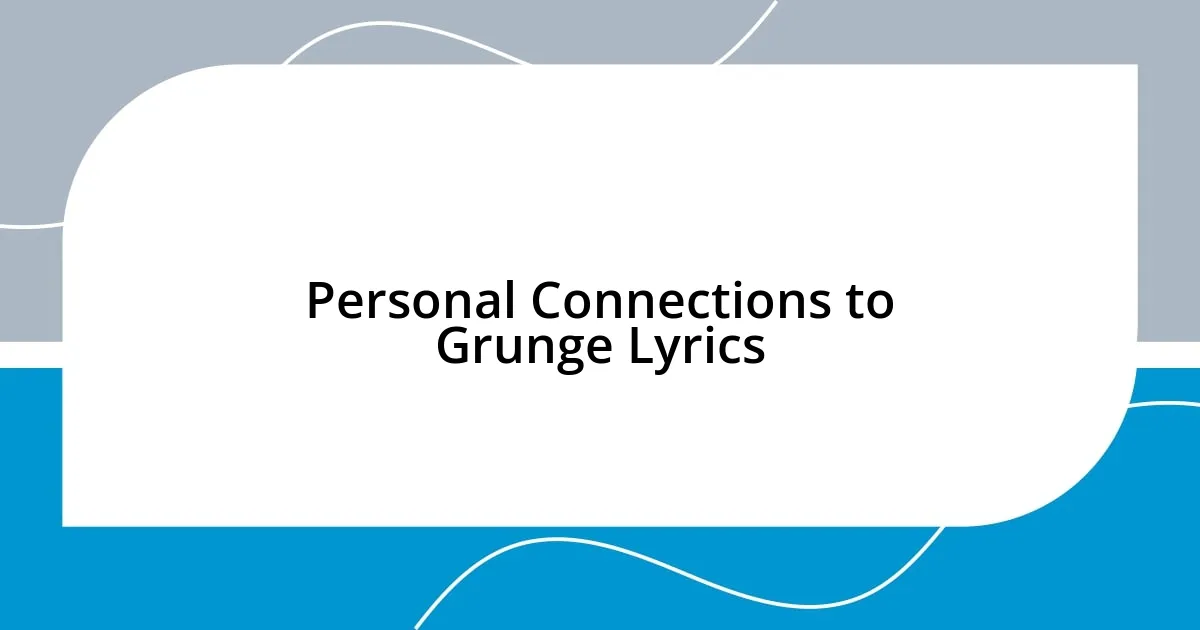
Personal Connections to Grunge Lyrics
The lyrics of grunge songs struck a deep chord with me. I clearly recall the first time I listened to “Black” by Pearl Jam; the way Eddie Vedder’s voice seemed to echo my own feelings of heartbreak and longing felt like he was speaking directly to me. It was as if he was giving voice to the quiet struggles I had kept hidden, sparking a connection that still lingers to this day.
There’s something profoundly cathartic about the rawness of grunge lyrics. I often found myself diving into the somber depths of Nirvana’s “Something in the Way.” It wasn’t just the haunting melody; it was the stark vulnerability in the words that resonated with my often tumultuous emotions. Questions like, “Have you ever felt completely isolated, even in a crowded room?” became a common thread in my reflections. Listening to that song made me realize I wasn’t alone in my feelings of disconnection.
Throughout my experience with grunge, I came to appreciate how it encapsulated a collective angst. Elaborate metaphors were stripped away, revealing unfiltered emotions. I remember standing in my room with “Rooster” by Alice in Chains playing. It was more than music; it was storytelling that felt all too real. When they sang about the pain of loss and struggle, I felt a shared understanding, as though the lyrics were intertwining with my own life experiences. In those moments, it wasn’t just about listening; it was about truly connecting.

Discovering Grunge’s Cultural Impact
Grunge’s cultural impact extends beyond gritty guitar riffs and anguished lyrics; it encapsulates a spirit of rebellion that resonated with so many of us during a transformative time. I can still vividly recall the atmosphere during the 90s, where flannel shirts, combat boots, and piercings became the unofficial uniform for youth searching for authenticity. It was a shared expression, a way to say, “We’re here, and we’ve got something to say.” This aesthetic was not just fashion; it was a visual language that spoke volumes about individuality and angst.
The grunge movement also sparked a dialogue around deeper societal issues, from mental health struggles to critiques of consumer culture. I remember watching interviews with Kurt Cobain, where he openly discussed his battles with depression and the pressures of fame. It made me think: how often do we feel the need to mask our true selves to fit societal expectations? The vulnerability he showcased resonated deeply with my own experiences, and it emboldened many of us to confront our realities rather than hide them.
Ultimately, the music and culture of grunge fostered a sense of community that transcended geographical boundaries. I found solace in connecting with friends over our shared admiration for the genre. One night, listening to “Plush” by Stone Temple Pilots, we debated what the lyrics meant to us, feeling invigorated by the discussion. Whether through lyrics, style, or conversations, grunge built an inclusive space where feelings were validated, and our collective stories intertwined. In those moments, I recognized that finding myself in grunge wasn’t just about personal discovery; it meant joining a larger narrative that echoed with honesty and authenticity.
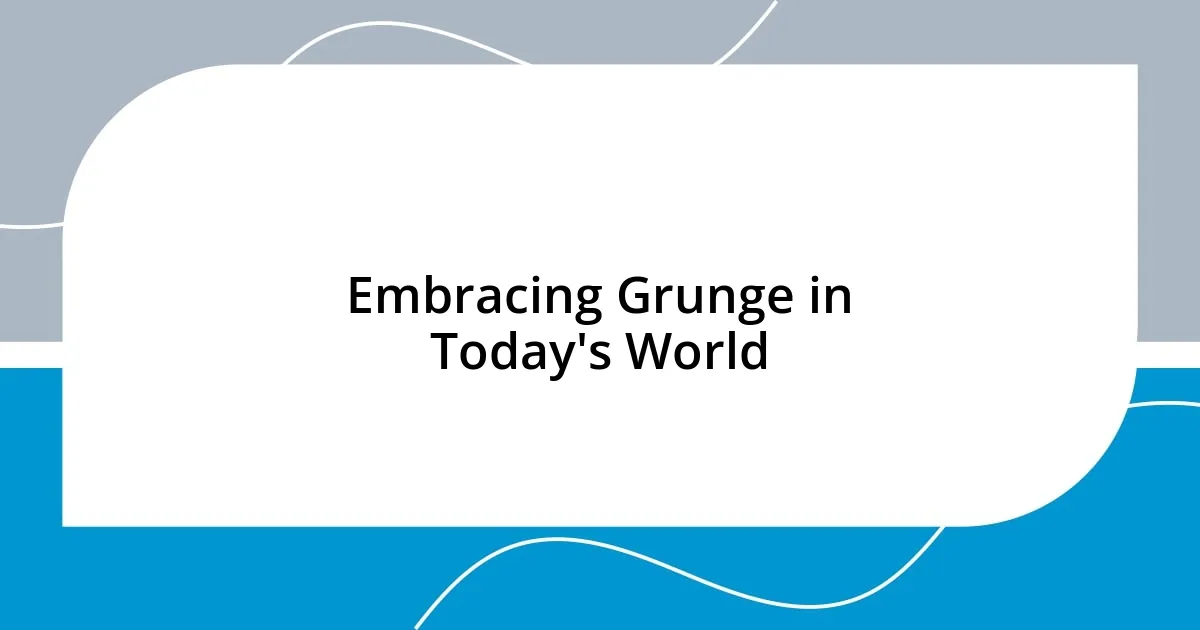
Embracing Grunge in Today’s World
Embracing grunge in today’s world feels like wearing a comfortable old sweater that still has its charm. I remember the first chilly autumn day when I decided to don my dad’s vintage flannel while heading out with friends. It wasn’t just about the fabric; it was a statement of rebellion against the polished expectations of mainstream fashion. In a society where trends change at the speed of light, wouldn’t it be refreshing to hold onto authenticity, even if that means embracing a bit of grunge?
Grunge, with its inherent rawness, resonates even now when so many of us grapple with complex emotions in a fast-paced world. Recently, I found myself revisiting “Heart-Shaped Box” by Nirvana and was struck by how its haunting lyrics mirrored the feelings of isolation I sometimes experience, particularly during stressful weeks at work. I can’t help but wonder, do others feel the weight of modern life lifting slightly when they connect with that anguish? For me, it’s the sound of guitar riffs and the intensity of emotion that help navigate my own struggles.
While some view grunge as a relic of the past, I believe it thrives in modern interpretations. Whether it’s through new music that channels that angst or artists who pay homage to the ’90s aesthetic, grunge seems to spur conversations about vulnerability that still matter today. I cherish those moments with my friends when we swap playlists and argue over which album truly captures the essence of feeling “lost.” It’s a reminder that despite the years that have passed, the spirit of grunge lives on, urging us to embrace our authenticity and find solace in shared experiences. How refreshing is it to know that this genre inspires a new generation to wear their emotions on their sleeves?











